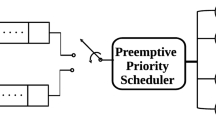Abstract
Personal Communication Networks (PCNs) have become an important filed of activity and they are expected to play a fundamental role in next-generation telecommunication systems. In particular, the emerging personal communication services, such as portable computing, paging, personal e-mail, etc. have led to the need of an efficient integration of voice and data traffic in a same PCN by means of a suitable multiple-access scheme. This paper considers stability and optimization issues for the Packet Reservation Multiple Access (PRMA) protocol used for integrating voice and burst data traffic in a PCN. An important result here devised is that the optimized PRMA protocol permits to be achieved good performance even under heavy traffic load conditions.
Similar content being viewed by others
References
P.T. Brady, A model for generating on-off speech patterns in two way conversation, Bell Systems Technical Journal 48(7) (September 1969) 2445-2472.
D.J. Goodman, Cellular packet communications, IEEE Transactions on Communications 38 (August 1990) 1272-1280.
D.J. Goodman, R.A. Valenzuela, K.T. Gayliard and B. Ramanurthi, Packet reservation multiple access for local wireless communications, IEEE Transactions on Communications 37 (August 1989) 885-890.
D.J. Goodman and S.X. Wei, Efficiency of packet reservation multiple access, part II, IEEE Transactions on Vehicular Technology 40(1) (February 1991) 170-176.
J.G. Gruber and L. Strawczynski, Subjective effects of variable delay and speech clipping in dynamically managed voice systems, IEEE Transactions on Communications 33 (1985) 801-808.
L. Kleinrock, Queuing Systems (Wiley, New York, 1976).
A. Marlow, Mathematics for Operations Research (Dover, New York, 1993).
N.M. Mitrou, Th.D. Orinos and E.N. Protonotarios, A reservation multiple access protocol for microcellular mobile-communication systems, IEEE Transactions on Vehicular Technology 39(4) (November 1990).
S. Nanda, Stability evaluation and design of the PRMA joint voice data system, IEEE Transactions on Communications 42 (May 1994) 2092-2104.
S. Nanda, D.J. Goodman and U. Timor, Performance of PRMA: a packet voice protocol for cellular systems, IEEE Transactions on Vehicular Technology 40 (August 1991) 584-598.
P. O'Reilly, A fluid-flow approach to performance analysis of integrated voice-data systems with speech interpolation, in: Modelling Techniques and Tools for Performance Analysis '85, ed. N. Abu El Ata (North-Holland/Elsevier, New York, 1986).
K. Sriram, P.K. Varshney and G.J. Shanthikumar, Discrete-time analysis of integrated voice/data multiplexers with and without speech activity detectors, IEEE Journal on Selected Areas in Communications 1 (May 1994) 2092-2104.
T. Suda and T.T. Bradley, Packetized voice/data integrated transmission on a token passing ring local area network, IEEE Transactions on Communications 37 (March 1989) 238-244.
S. Tasaka, Stability and performance of the R-ALOHA packet broadcast system, IEEE Transactions on Computers 32 (August 1983) 717-726.
Author information
Authors and Affiliations
Rights and permissions
About this article
Cite this article
Fantacci, R. Stability and Optimization Analysis for the PRMA Protocol for Voice and Burst Data Integration in a Personal Communication Network. Telecommunication Systems 17, 115–133 (2001). https://doi.org/10.1023/A:1016656120231
Issue Date:
DOI: https://doi.org/10.1023/A:1016656120231




